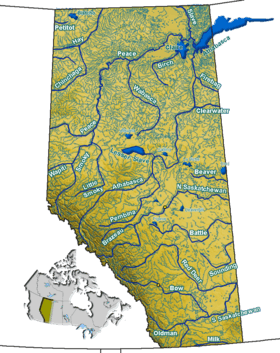Frank Lake (Alberta)
| Frank Lake | |
|---|---|
| Location | Municipal District of Foothills No. 31, Alberta |
| Coordinates | 50°34′01″N 113°42′29″W / 50.567°N 113.708°WCoordinates: 50°34′01″N 113°42′29″W / 50.567°N 113.708°W |
| Type | Marsh |
| Primary outflows | Little Bow River |
| Basin countries | Canada |
| Surface area | 43.74 km2 (16.89 sq mi) |
| Surface elevation | 1,000 metres (3,300 ft) |
Frank Lake is a restored wetland located 6 km (3.7 mi) east of High River, Alberta, 50 km (31 mi) south of Calgary, and about 2 km (1.2 mi) south of Blackie. The lake is controlled by Ducks Unlimited Canada for wildlife management purposes, and is an Important Bird Area. It is one of four Alberta lakes with the same name.[1]
Conservation and management
The lake has had a history of years of being completely dry, and years of being flooded. The main goal of managing Frank Lake is to ensure that the lake is a permanent waterbody, which will improve wildlife habitat.
Water control measures have been implemented to help ensure that water levels are maintained. Measures include the building of dikes and water control structures as well as the building of a pipeline from High River to channel treated effluent from the town of High River and a local food processing plant. Water quality is regularly monitored.
Nesting boxes, nesting platforms, and rock islands are among the structures placed around the lake to encourage nesting and improve habitat. The Important Bird Areas program considers Frank Lake to be the most important wetland in southwestern Alberta for the production of waterfowl and other water birds.[2]
Wildlife
The lake and its surrounding upland areas attracts many species of birds. Waterfowl and shorebirds and other birds use the lake for staging during migration, and nesting. Some birds that can be seen here include: tundra swan, trumpeter swan, Canada goose, northern pintail, Franklin's gull, ring-billed gull, California gull, common tern, short-eared owl, eared grebe, marbled godwit, long-billed dowitcher, black-crowned night-heron, and black-necked stilt. Birdwatching is a popular activity.
Citations
- ↑ Natural Resources Canada - Geographical Names of Canada Retrieved April 29, 2012
- ↑ Important Bird Areas in Canada - Frank Lake Retrieved April 29, 2012
References
- Ducks Unlimited Canada - Frank Lake Retrieved October 8, 2012
- Nature Calgary - Frank Lake Retrieved April 29, 2012
- Important Bird Areas in Canada - Frank Lake Retrieved April 29, 2012
- Government of Alberta - An Overview of Water Quality in Frank Lake 1990-1993 Retrieved April 29, 2012
External links
- Restoration of a Canadian Prairie Wetland with Agricultural and Municipal Wastewater
- Birding at Frank Lake Conservation Area
- ebird Canada - Bird Observations, Frank Lake (south)
